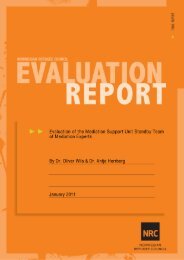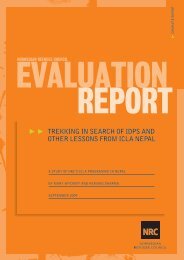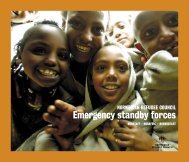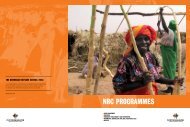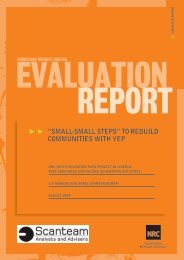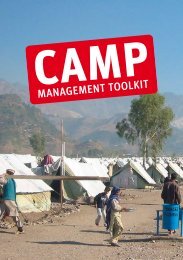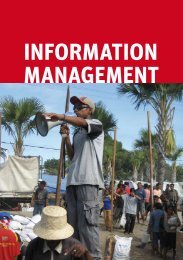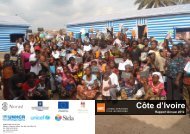evaluation of general food distribution in northern uganda: gulu ...
evaluation of general food distribution in northern uganda: gulu ...
evaluation of general food distribution in northern uganda: gulu ...
Create successful ePaper yourself
Turn your PDF publications into a flip-book with our unique Google optimized e-Paper software.
expected <strong>of</strong> them. From their perspective, ”support<strong>in</strong>g livelihoods dur<strong>in</strong>g this transition periodis more complicated and requires more resources and expertise particularly given theweakened capacity <strong>of</strong> the district production department” 160 .While stakeholders (GOU, donors, UN agencies, NGOs) are <strong>in</strong> agreement on the need forthe concurrent implementation <strong>of</strong> relief and recovery activities to mitigate the impact <strong>of</strong> asudden withdrawal, the l<strong>in</strong>k between the two (transition) has become a ‘grey’ area affectedby the absence/slow release <strong>of</strong> funds. Attempts were made to <strong>in</strong>clude recovery activities <strong>in</strong>the Consolidated Appeals Process, but as <strong>of</strong> May 2008, only 22% out <strong>of</strong> USD 400 millionrequested for has been realized (the Food security cl uster – exclud<strong>in</strong>g <strong>food</strong> aid - <strong>in</strong> particularappears to have attracted the least funds 161 ). It would appear that fund<strong>in</strong>g agencies, thattraditionally support either relief or development activities are struggl<strong>in</strong>g with this ‘transitionidea’ <strong>in</strong> terms <strong>of</strong> policy, programm<strong>in</strong>g and fund<strong>in</strong>g. This situation is a classical example <strong>of</strong> thecompartmentalisation between humanitarian and development work 162 . It is also worth not<strong>in</strong>gthat hesitation to fund the transition could also be l<strong>in</strong>ked to the delayed sign<strong>in</strong>g <strong>of</strong> the peaceprocess and hence uncerta<strong>in</strong>ty on what is go<strong>in</strong>g to happen 163 .As mentioned earlier, the l<strong>in</strong>k between relief and recovery has also been affected by thedelayed and unclear implementation <strong>of</strong> the PRDP – which is supposed to establish thefoundation for the process i.e. through the various objectives. The total PRDP budgetcurrently stands at US$ 606,519,297, which has both created anticipation and someconfusion. Some <strong>of</strong> the common questions asked are: is this new money and how soon is itgo<strong>in</strong>g to be available? And to whom is it go<strong>in</strong>g to be allocated, NGOs or districts? What isthe absorptive capacity <strong>of</strong> districts to handle this money? How exactly the PRDP will befunded is still be<strong>in</strong>g discussed, but it could <strong>in</strong>volve either <strong>of</strong> these mechanisms 164 : i) reallocation<strong>of</strong> national expenditures; ii) <strong>in</strong>ternational co-f<strong>in</strong>anc<strong>in</strong>g through budget support; iii)<strong>in</strong>ternational co-f<strong>in</strong>anc<strong>in</strong>g through allocations at the district level by way <strong>of</strong> block grants; iv)establishment <strong>of</strong> a multi-donor trust fund; and v) parallel stand alone projects. This alsocreates uncerta<strong>in</strong>ty about the implementation mechanisms 165 , which will be determ<strong>in</strong>ed bythe different modes <strong>of</strong> fund<strong>in</strong>g. The situation has put stakeholders <strong>in</strong> a ‘wait<strong>in</strong>g position’ tosee GoUs next move. Consolidation <strong>of</strong> state authority an d specifically that <strong>of</strong> localgovernments appears particularly crucial to the recovery process and yet the formaladm<strong>in</strong>istrative structures are a long way <strong>of</strong>f <strong>in</strong> terms <strong>of</strong> capacity to manage the recovery anddevelopment processes” 166 .9.3 NRC’s Efforts Towards ConnectednessAdvocacy on Recovery: The GFD programme is develop<strong>in</strong>g an advocacy strategy thatrevolves around the issues under Strategic Objective 2 <strong>of</strong> the PRDP. GFD’s advocacy effortsare aimed at draw<strong>in</strong>g the attention <strong>of</strong> other actors to the needs <strong>of</strong> the IDPs <strong>in</strong> the camps andthose <strong>in</strong> the return areas and thereby guid<strong>in</strong>g recovery efforts. From its experiences <strong>in</strong> theprocess <strong>of</strong> <strong>food</strong> <strong>distribution</strong> as well as camp management, NRC has been able to identify anumber <strong>of</strong> issues affect<strong>in</strong>g the communities and particularly dur<strong>in</strong>g the resettlement process.Some <strong>of</strong> the advocacy messages that NRC is focus<strong>in</strong>g on: the basic needs <strong>of</strong> the population;voluntary return; the security and protection concerns, particularly <strong>of</strong> vulnerable persons e.g.children left <strong>in</strong> the ma<strong>in</strong> camps. NRC is also particularly concerned about the articulation andthe lack <strong>of</strong> <strong>in</strong>stitutional clarity <strong>of</strong> the early recovery cluster 167 , and is consider<strong>in</strong>g various160Interview with Country Director, AVSI161Interview with UNOCHA, Kitgum162Interview with Advocacy Advisor, NRC163Interview with humanitarian stakeholder164PRDP 2007 – 2010: Fund<strong>in</strong>g165European Union, 2007: Northern Uganda Agricultural Recovery Programme (NUARP) – An Identification Study, Volume 1166Interview with UNHCR167Interview with Protection and Advocacy Advisor, NRC47





